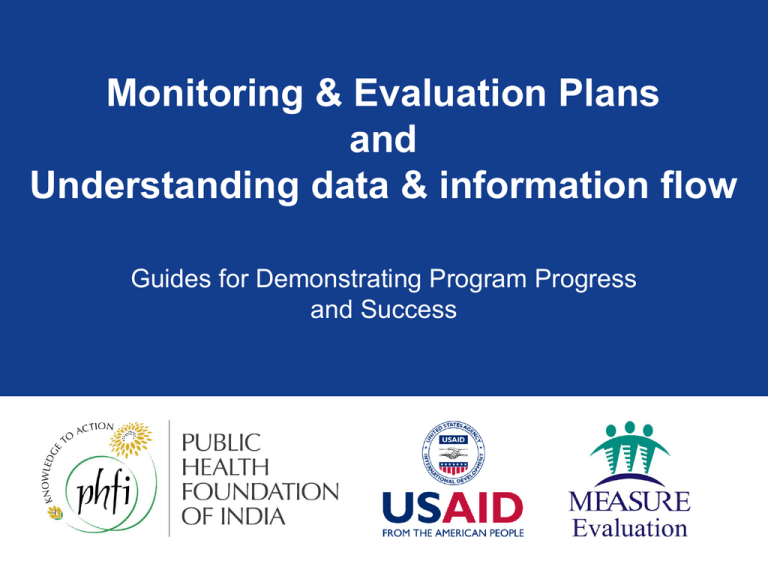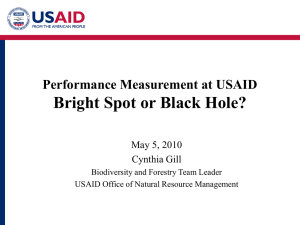
Monitoring & Evaluation Plans
and
Understanding data & information flow
Guides for Demonstrating Program Progress
and Success
Learning Objectives
Describe basic elements of M&E Plans
Understand basic function of Plan components
Identify opportunities for data demand and use
Apply the Information Use Map
Session Overview
Definition and function of M&E Plan
Describe components of a Plan
Basic rules to guide M&E Plan development
Introduce Tool: Information Use Map
Introduction to workshop group work:
Developing components of an M&E plan
M&E Plans – Definition1
Document describing all M&E activities in a
program
Program objectives, interventions developed to
achieve them, & procedures to be implemented to
determine whether or not objectives are met
Expected results of the program and how they relate
to goals and objectives
Data needed, how it will be collected & analyzed
Information use, including resources needed to do so
How the program will be accountable to stakeholders
1MEASURE
Evaluation website,
https://www.cpc.unc.edu/measure/training/mentor
M&E Plans - Function
Guides implementation of program M&E
Enhances coordination, standardization
States how program will measure achievements
Accountability
Documents stakeholder consensus
Transparency & responsibility
Helps achieve program results
Ensures good use of data
Preserves institutional memory
A living document, adjusted for program modification
M&E Plan Components
Introduction
Program Description
Goals and objectives
M&E Frameworks
Conceptual, Logic, Results
Indicators
Presented in a both a Matrix & Indicator
Reference Sheets
Data sources, collection & reporting systems
Plans for data use & dissemination
Information Use Mapping Tool as an option
M&E Plan Components
Capacity needs for Plan implementation
Funding, TA, staff, equipment (computers,
GPS)
Analysis of constraints & potential solutions
Plans for demonstrating program impact
Mechanism for Plan updates
M&E Plan Components - Introduction
Program Context
National, community-based
Nature of problem within the target population
Purpose of the Plan
Description of development process
Stakeholders involved
Consensus process
M&E Plan Components –
Program Description
Problem Statement
What is the nature of the HIV-related issue being
addressed?
Goal and Objectives
What is the ultimate outcome of the program (goal)
What are the shorter-term aims (objectives)
Program Description
Intervention(s), geographic scope, target population,
duration
M&E Plan Components – M&E
Frameworks
Conceptual: shows how program fits into causal
pathway to desired health outcome
Logic: shows program components that will
contribute to the long and short-term outcomes
Programmatic-specific frameworks
Results for USAID/PEPFAR
M&E Plan Components – Indicators
Selection based on
Logic models
Donor requirements
Presented in 2 ways
Indicator Matrix (pp. 40-45, VN National Plan)
Table presenting indicators including information on
data source, frequency, who is responsible, etc.
Indicator Reference Sheets (pp. 46-107)
Detailed sheet describing each indicator, how to
measure it, underlying assumptions & interpretation
considerations
M&E Plan Components – Data
Sources used for inputs to indicators
Existing/routine data
Planned studies
Special systems/studies for program
Collection tools for program
Patient records, supplies, clinic records for use of
services
Reporting systems
Upward and downward flow of data
M&E Plan Components – Data Use
Specify plans for data use
Identify
Databases for storage
Who the users are
Dissemination methods including
Reports, media, speaking events
Apply Information Use Map tool to understand
data flow and enhance use
Understanding Data Flow
Helps us better understand our role in health
information system and importance of
collecting data
Identify opportunities for improving data
collection, analysis, increase availability, and
ensure its use
Information Flow
Feedback
Program
Clinical
histories,
service
statistics
Compiled
data
Service Delivery
Point
Reports
Managers,
Government
, Donors
Analysts,
evaluators
Higher levels: district, province,
national
Reasons to Assess Information
Flow
Local data not used locally
Higher-level information does not return back to
local level
Local data not assessed in broad context
Reports may not reflect what is being collected &
is needed (e.g., sex differentiation)
Little incentive to produce high-quality data
16
INFORMATION USE MAP
Information Use Mapping
Purpose
Describe existing flow of health information to identify
opportunities for improving its use
Description
Identifies gaps and opportunities for using
information
Identifies opportunities for additional feedback
mechanisms
Identifies points where analysis & data could support
programmatic decision making
Information Use Map: Swaziland National HIV/AIDS Program
May 2005
NGOs
Client data
collected
in registers
Regional
Client data
collected in
electronic
patient record
systems
SNAP/MOHSW
NERCHA
Compilation
Storage
Analysis
Reporting
Client data
collected in
electronic
patient record
systems
Government Facilities
Private Clinics
Data Collection
Client data
stored in
electronic
patient record
systems
Staff
compiles into
monthly
summary
sheets
Regional
facilities’
monthly
summary sheets
compiled
Data entered
into Access at
MOH Health
Statistics or
NERCHA
Reporting
to WHO or
GFATM
Use
Information Use Map: Swaziland National HIV/AIDS Program
May 2005
NGOs
Government Facilities
Client data
collected
in registers
Regional
Compilation
Storage
Analysis
Reporting
Client data
collected in
electronic
patient record
systems
Client data
collected in
electronic
patient record
systems
SNAP/MOHSW
NERCHA
Feedback Loops
Private Clinics
Data Collection
Use
Opportunities
for Use
Client data
stored in
electronic
patient record
systems
Opportunities
for Use
Staff
compiles into
monthly
summary
sheets
Opportunities
for Use
Regional
facilities’
monthly
summary sheets
compiled
Opportunities
for Use
Data entered
into Access at
MOH Health
Statistics or
NERCHA
Reporting
to WHO or
GFATM
Opportunities
for Use
Key Messages
Actual flow of data and information can
reveal barriers to improving data quality
and use
Information Use Map can highlight
intervention points
21
M&E Plan Components
Capacity needs for plan implementation
Identify resources needed to implement plan
Funding, technical capacity, equipment etc.
Analysis of constraints
Be realistic; may be connected to above
Plans for demonstrating program impact
Evaluation probably not covered by monitoring indicators
Mechanism for Plan updates
Depending on length of program - annual, semi-annual
An M&E Plan should be
Practical
Accessible to intended users
Feasible, realistic, & diplomatic
Legal & ethical
Accurate
Reveal technically correct information
M&E Plan Development
Advocate for the need for M&E
Assess program information needs
Assess existing system capabilities to address these
needs
Achieve consensus and commitment among
stakeholders
Indicators & reporting structure
Prepare document for final approval
M&E plan should be written during the initial stages of program development
Workshop Group Project
Developing components of
an M&E Plan
Workshop Group Project:
Developing Components of an M&E Plan
Goal
Put workshop learning to practical use with real
life case studies
All case studies for projects provided by you
In total, 5-6 groups
Minimum of 3, max of 4 people
Sign up for top 2 choices after this session
Workshop Group Project:
Assignment
Total of 5-6 groups
Look to author for missing information, or create
plausible conditions
As part of workshop sessions, all groups
Logic model
Some indicator selection
Some tool utilization
Remaining work is your choice: Focus on some M&E
Plan components & use tools presented
Develop real components – detailed
Nature of program description may dictate some of what
needs to be done
Information Use Map Activity for Group
Work:
Complete the Information Use Map for your
organization as data flows now
Review the map and discuss among your group how
the flow of information could be improved:
How else could data be analyzed?
Are there opportunities for feedback mechanisms?
Is data being used by all stakeholders?
Note potential interventions based on your
discussion.
Make a 2nd version of the map to illustrate an
improved flow of information
28
Small Group Activity: Report Back
1.
One group member remain at the table to present the map
to visitors
2.
Each table moves to the right to visit the table next to
them.
3.
The table presenter spends 5 minutes explaining how they
improved information flow in their map and how this would
facilitate use of data.
4.
Repeat steps 2-3
5.
Everyone returns to original tables
6.
Consider improving your map based on what you learned
from your neighbors.
MEASURE Evaluation is a MEASURE project funded by the
U.S. Agency for International Development and implemented by
the Carolina Population Center at the University of North Carolina
at Chapel Hill in partnership with Futures Group International,
ICF Macro, John Snow, Inc., Management Sciences for Health,
and Tulane University. Views expressed in this presentation do not
necessarily reflect the views of USAID or the U.S. Government.
MEASURE Evaluation is the USAID Global Health Bureau's
primary vehicle for supporting improvements in monitoring and
evaluation in population, health and nutrition worldwide.












